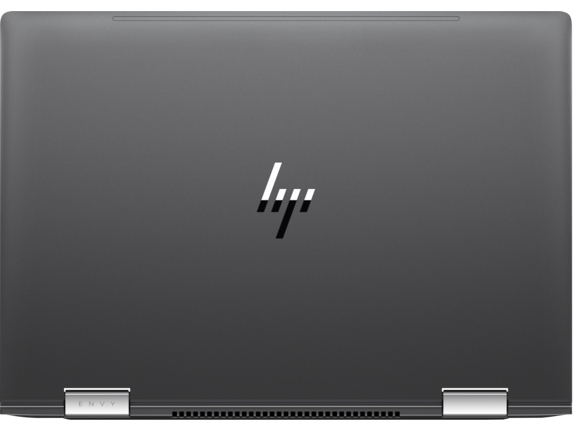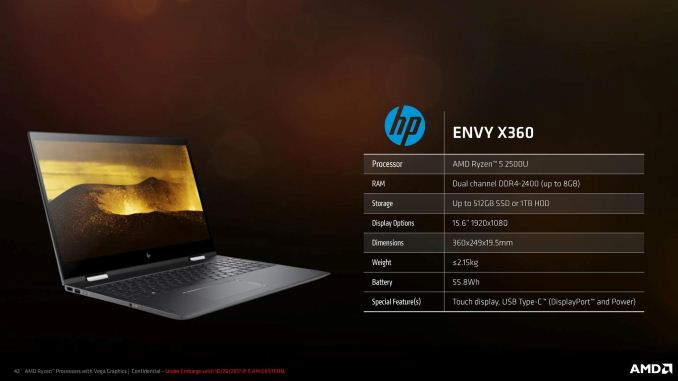HP Announces ENVY x360 15 With Ryzen Mobile
by Brett Howse on October 26, 2017 9:01 AM EST- Posted in
- Laptops
- AMD
- HP
- Convertible
- Vega
- Ryzen
- Ryzen Mobile

As part of the launch for the new Ryzen Mobile platform from AMD, HP is today announcing a refresh of their HP ENVY x360 15-inch laptop which features the AMD Ryzen 5 2500U processor. This refresh is based off their existing AMD FX series x360. The HP ENVY x360 has been a popular platform for HP, offering a fully convertible laptop with a 360° hinge, offering traditional laptop weight balance, along with stand, tent, and tablet modes to increase the versatility.
| HP ENVY x360 Ryzen Mobile | |||||
| CPU | AMD Ryzen 5 2500U Quad-core, Eight-thread, 2.0GHz to 3.6GHz |
||||
| GPU | AMD Radeon Vega 8 Graphics 8 Radeon RX Vega CUs Up to 1100 MHz |
||||
| Display | 15.6" 1920x1080 IPS with Touch | ||||
| Memory | Up to 8 GB DDR4 (2 DIMMs) | ||||
| Storage | Up to 512 GB SSD or 1 TB HDD | ||||
| Wireless | Intel 802.11ac w/Bluetooth 4.2 | ||||
| I/O | 1 USB-C 3.1 Gen 1 with DP 1.2 and Power 2 USB 3.0 1 HDMI Headset Jack |
||||
| Power | 65W AC Adapter 55.8 Wh Battery |
||||
| Dimensions | 14.16"x9.8"x0.77" | ||||
| Weight | 4.75 lbs | ||||
| Starting Price | $699 | ||||
| Availability | November 2017 | ||||
But the star of the show is going to be the Ryzen Mobile processor. HP is offering the Ryzen 5 2500U option, which is four cores, eight threads, and a 2.0 GHz base frequency with 3.6 GHz boost frequency. As with Intel’s CPUs, it has a 15-Watt nominal TDP. HP has paired it with up to 8 GB of DDR4 RAM in dual-channel mode.
The GPU side is where we expect Ryzen Mobile to have an edge, thanks to the Radeon Vega graphics core. In the Ryzen 5 2500U, this means eight Radeon RX Vega CUs, with a boost frequency of up to 1100 MHz. It’ll be exciting to see what this integrated graphics core will be able to achieve with just a 15-Watt TDP.
The CPU change is clearly the big change. The rest of the laptop is similar to the existing HP ENVY x360 15-inch model. It offers up to a 512 GB SSD, or 1 TB SATA HDD, and features Intel 802.11ac wireless. The display is a 15.6-inch IPS 1920x1080 panel, featuring thin side bezels and edge-to-edge glass. The laptop features an IR webcam for Windows Hello support, and offers a full-size backlit keyboard with a number pad as well. The laptop weighs in at 4.75 lbs.
For connectivity and more, the HP ENVY x360 offers USB-C with DisplayPort and power capabilities, and HP lists the laptop as able to drive two UHD displays. HP’s partnership with Bang & Olufsen continues as well, handling the audio duties. It also features a stylus for Windows Ink.
The Ryzen Mobile powered HP ENVY x360 starts at $699, with availability in November.
Source: HP











43 Comments
View All Comments
yannigr2 - Thursday, October 26, 2017 - link
Memory pricing has nothing to do with how much memory the system can see.Topweasel - Thursday, October 26, 2017 - link
You are assuming it's the limit of the platform and not a limit of the offered memory choices (4GB or 8GB). The up too is the variations they are offering.yannigr2 - Friday, October 27, 2017 - link
So if a customer goes to them and say "Can you put 16GB in it, don't care about the costs", are they going to say him "No, we only offer it with 4GB or 8GB"? Does this sounds logical to you? I mean, give the impression that this laptop can not accept more memory when in fact it can. And if yes, why?Mikewind Dale - Tuesday, October 31, 2017 - link
If a customer asks for 16 GB, I think that HP will indeed say no. Why, you ask? Simple: price discrimination. They want to force you to buy a more expensive laptop from another product line. Let me tell you a story about my own experience with HP:About a year ago, I was buying my mother a new laptop. All she does is check email and edit Word documents, so performance was not necessary. Basically, the only strict requirement was that it be 17" (so that everything is bigger for her eyes). But I also wanted to get an SSD because I didn't want her to deal with any hourglasses.
So I decided to get her an AMD APU-based laptop - nice and cheap, with decent enough performance for her needs. HP had the best prices, so I decided to go with them.
Unfortunately, HP's cheapest 17" AMD laptop only offered a mechanical hard drive. It was a steal at $300-something, but damnit, I wanted an SSD. I called HP on the phone to ask whether they could throw in an SSD. They said no, but that if I wanted to, I could buy a totally separate laptop, for about $1,000, that had both an SSD and a dedicated graphics card and a whole bunch of other useless features.
So basically, HP was artificially segmenting their own product line. They refused to upgrade a $300 laptop by adding a $150 SSD, and they wanted me to buy a $1,000 laptop instead.
So in the end, I bought the $300 laptop and I upgraded it myself with a Crucial MX300. But if my mother had to do it all herself, and she didn't have me around to upgrade the laptop, she'd have had to make a choice between a $300 laptop with a mechanical hard drive or a $1,000 laptop with an SSD (and a dedicated graphics card and a bunch of other useless features).
Again, it's price discrimination. You artificially segment the market, charging different people a different price for goods which cost the same amount to manufacture. Price discrimination requires an effective means of sorting people with different willingnesses to pay. This sorting mechanism requires the seller to be inflexible, or else their sorting mechanism will fail. Other familiar examples of price-discrimination include:
--- CPUs made from the same die but with very different features (e.g. speed, cache, etc.)
--- Senior discounts and student discounts
As I said, price discrimination requires the seller to be inflexible. You have to set a rule and stick to it, or else people will engage in arbitrage, buying low and selling high and circumventing the attempted discrimination. For example, if all CPUs were totally unlocked in every way, with a 2-core processor having 14 disabled cores, everyone would just buy the 2-core processor and unlock the other 14. Similarly, if movie tickets were unlimited, applying to all movies at all times, then a student could just buy a massive number of generic tickets with a student discount and scalp them all for a higher price. So price discrimination requires that the seller set strict rules which effectively sort people according to willingness to pay, and those rules cannot be broken or else the scheme fails. So HP couldn't put a $150 SSD into their $300 laptop because then a lot of people would stop buying the $1,000 laptop with the dedicated graphics card.
Mikewind Dale - Tuesday, October 31, 2017 - link
... similarly, I think that HP is constraining their AMD Ryzen laptop to 8 GB RAM so that people who want 16 GB will be forced to buy a more expensive Intel laptop.Jleppard - Friday, November 10, 2017 - link
If you goto HP website you have the option to get 2 x 8 = 16 or 4 x 8 = 12. HP has done good to have options with this. Every type of HD and M.2 is offeredyeeeeman - Thursday, October 26, 2017 - link
This actually looks remarkably good. ~ 2kg, full hd ips screen, base platform with cpu/gpu is always included so only ram and ssd can change the 699$ starting price. If battery life is comparable to Intel, then they might have a winner here.IGTrading - Thursday, October 26, 2017 - link
For the same performance, battery life will be better.For max performance, battery life will be comparable.
If they manage better performance AND better autonomy, then Intel's Christmas Season sales will only be fueled by ignorant buyers willing to throw more than 600 USD on products they have no idea about :)
The fact that Intel maintained around 70% market share for 7 years between 1999 and 2006 while selling under-performing, unreliable, overheating, overpriced crap is proof that stupidity and ignorance still ruled the world at the time.
We hope today, with the incredible reach of the Internet, people will be smart, informed and not let themselves manipulated by the billions in bribes Intel has been paying for the past 2 decades : https://www.youtube.com/watch?v=osSMJRyxG0k
yannigr2 - Thursday, October 26, 2017 - link
So Intel will have to base all it's hopes to 90% of the consumers who have no idea what they are buying and the rest 10%, who try to find an AMD design that does not look problematic and they can't, because they are only 10 of them and all have either ridiculous prices or/and ridiculous specs and limitations and poor quality design.I better sell my house and buy Intel stock.
yannigr2 - Thursday, October 26, 2017 - link
And no, it's not stupidity and ignorance. It's just monopoly and simple numbers. From a shop self with 50 Intel "under-performing, unreliable, overheating, overpriced crap" and 5 AMD laptops that are promoted from the sales stuff as "under-performing, unreliable, overheating, overpriced crap", because Intel models return higher profit margins to the shop, what do you expect people will buy?